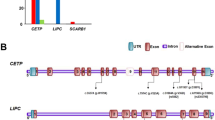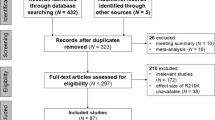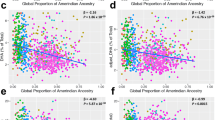Abstract
The ω-hydroxylase CYP4A11 catalyzes the transformation of epoxyeicosatrienoic acids (EETs) to ω-hydroxylated EETs, endogenous peroxisome proliferator-activated receptor-α (PPARα) agonists. PPARα activation increases high-density lipoprotein cholesterol (HDL-C). A cytosine-for-thymidine (T8590C) variant of CYP4A11 encodes for an ω-hydroxylase with reduced activity. This study examined the relationship between CYP4A11 T8590C genotype and metabolic parameters in the Framingham Offspring Study and in a clinical practice-based biobank, BioVU. In women in the Framingham Offspring Study, the CYP4A11 8590C allele was associated with reduced HDL-C concentrations (52.1±0.5 mg dl−1 in CYP4A11 CC- or CT-genotype women versus 54.8±0.5 mg dl−1 in TT women at visit 2, P=0.02), and with an increased prevalence of low HDL-C, defined categorically as ⩽50 mg dl−1 (odds ratio 1.39 (95% CI 1.02–1.90), P=0.04). In the BioVU cohort, the CYP4A11 8590C allele was also associated with low HDL-C in women (odds ratio 1.69 (95% CI 1.03–2.77, P=0.04)). There was no relationship between genotype and HDL-C in men in either cohort.
This is a preview of subscription content, access via your institution
Access options
Subscribe to this journal
Receive 6 print issues and online access
$259.00 per year
only $43.17 per issue
Buy this article
- Purchase on Springer Link
- Instant access to full article PDF
Prices may be subject to local taxes which are calculated during checkout


Similar content being viewed by others
References
Carroll MA, McGiff JC . A new class of lipid mediators: cytochrome P450 arachidonate metabolites. Thorax 2000; 55 (Suppl 2): S13–S16.
Sarkis A, Lopez B, Roman RJ . Role of 20-hydroxyeicosatetraenoic acid and epoxyeicosatrienoic acids in hypertension. Curr Opin Nephrol Hypertens 2004; 13: 205–214.
Cowart LA, Wei S, Hsu MH, Johnson EF, Krishna MU, Falck JR et al. The CYP4A isoforms hydroxylate epoxyeicosatrienoic acids to form high affinity peroxisome proliferator-activated receptor ligands. J Biol Chem 2002; 277: 35105–35112.
Gatica A, Aguilera MC, Contador D, Loyola G, Pinto CO, Amigo L et al. P450 CYP2C epoxygenase and CYP4A omega-hydroxylase mediate ciprofibrate-induced PPARalpha-dependent peroxisomal proliferation. J Lipid Res 2007; 48: 924–934.
Nissen SE, Nicholls SJ, Wolski K, Howey DC, McErlean E, Wang MD et al. Effects of a potent and selective PPAR-alpha agonist in patients with atherogenic dyslipidemia or hypercholesterolemia: two randomized controlled trials. JAMA 2007; 297: 1362–1373.
Cuzzocrea S, Mazzon E, Di PR, Peli A, Bonato A, Britti D et al. The role of the peroxisome proliferator-activated receptor-alpha (PPAR-alpha) in the regulation of acute inflammation. J Leukoc Biol 2006; 79: 999–1010.
Gainer JV, Bellamine A, Dawson EP, Womble KE, Grant SW, Wang Y et al. Functional variant of CYP4A11 20-hydroxyeicosatetraenoic acid synthase is associated with essential hypertension. Circulation 2005; 111: 63–69.
Mayer B, Lieb W, Gotz A, Konig IR, Aherrahrou Z, Thiemig A et al. Association of the T8590C polymorphism of CYP4A11 with hypertension in the MONICA Augsburg echocardiographic substudy. Hypertension 2005; 46: 766–771.
Hermann M, Hellermann JP, Quitzau K, Hoffmann MM, Gasser T, Meinertz T et al. CYP4A11 polymorphism correlates with coronary endothelial dysfunction in patients with coronary artery disease-The ENCORE Trials. Atherosclerosis 2009; 207: 476–479.
Fava C, Montagnana M, Almgren P, Rosberg L, Lippi G, Hedblad B et al. The V433M variant of the CYP4F2 is associated with ischemic stroke in male Swedes beyond its effect on blood pressure. Hypertension 2008; 52: 373–380.
Ward NC, Tsai IJ, Barden A, van Bockxmeer FM, Puddey IB, Hodgson JM et al. A single nucleotide polymorphism in the CYP4F2 but not CYP4A11 gene is associated with increased 20-HETE excretion and blood pressure. Hypertension 2008; 51: 1393–1398.
Sugimoto K, Akasaka H, Katsuya T, Node K, Fujisawa T, Shimaoka I et al. A polymorphism regulates CYP4A11 transcriptional activity and is associated with hypertension in a Japanese population. Hypertension 2008; 52: 1142–1148.
Gainer JV, Lipkowitz MS, Yu C, Waterman MR, Dawson EP, Capdevila JH et al. Association of a CYP4A11 variant and blood pressure in black men. J Am Soc Nephrol 2008; 19: 1606–1612.
Kannel WB, Feinleib M, McNamara PM, Garrison RJ, Castelli WP . An investigation of coronary heart disease in families. The Framingham offspring study. Am J Epidemiol 1979; 110: 281–290.
Ritchie MD, Denny JC, Crawford DC, Ramirez AH, Weiner JB, Pulley JM et al. Robust replication of genotype-phenotype associations across multiple diseases in an electronic medical record. Am J Hum Genet 2010; 86: 560–572.
Wilke RA . High-density lipoprotein (HDL) cholesterol: leveraging practice-based biobank cohorts to characterize clinical and genetic predictors of treatment outcome. Pharmacogenomics J 2011; 11: 162–173.
Denny JC, Ritchie MD, Basford MA, Pulley JM, Bastarache L, Brown-Gentry K et al. PheWAS: demonstrating the feasibility of a phenome-wide scan to discover gene-disease associations. Bioinformatics 2010; 26: 1205–1210.
Yoon M . The role of PPARalpha in lipid metabolism and obesity: focusing on the effects of estrogen on PPARalpha actions. Pharmacol Res 2009; 60: 151–159.
Kleemann R, Gervois PP, Verschuren L, Staels B, Princen HM, Kooistra T . Fibrates down-regulate IL-1-stimulated C-reactive protein gene expression in hepatocytes by reducing nuclear p50-NFkappa B-C/EBP-beta complex formation. Blood 2003; 101: 545–551.
Scott R, Best J, Forder P, Taskinen MR, Simes J, Barter P et al. Fenofibrate Intervention and Event Lowering in Diabetes (FIELD) study: baseline characteristics and short-term effects of fenofibrate [ISRCTN64783481]. Cardiovasc Diabetol 2005; 4: 13.
Keech A, Simes RJ, Barter P, Best J, Scott R, Taskinen MR et al. Effects of long-term fenofibrate therapy on cardiovascular events in 9795 people with type 2 diabetes mellitus (the FIELD study): randomised controlled trial. Lancet 2005; 366: 1849–1861.
Do HQ, Nazih H, Luc G, Arveiler D, Ferrieres J, Evans A et al. Influence of cholesteryl ester transfer protein, peroxisome proliferator-activated receptor alpha, apolipoprotein E, and apolipoprotein A-I polymorphisms on high-density lipoprotein cholesterol, apolipoprotein A-I, lipoprotein A-I, and lipoprotein A-I:A-II concentrations: the Prospective Epidemiological Study of Myocardial Infarction study. Metabolism 2009; 58: 283–289.
Flavell DM, Pineda Torra I, Jamshidi Y, Evans D, Diamond JR, Elkeles RS et al. Variation in the PPARalpha gene is associated with altered function in vitro and plasma lipid concentrations in Type II diabetic subjects. Diabetologia 2000; 43: 673–680.
Chan E, Tan CS, urenberg-Yap M, Chia KS, Chew SK, Tai ES . The V227A polymorphism at the PPARA locus is associated with serum lipid concentrations and modulates the association between dietary polyunsaturated fatty acid intake and serum high density lipoprotein concentrations in Chinese women. Atherosclerosis 2006; 187: 309–315.
Abbott RD, Wilson PW, Kannel WB, Castelli WP . High density lipoprotein cholesterol, total cholesterol screening, and myocardial infarction. The Framingham Study. Arteriosclerosis 1988; 8: 207–211.
Kessling A, Ouellette S, Bouffard O, Chamberland A, Betard C, Selinger E et al. Patterns of association between genetic variability in apolipoprotein (apo) B, apo AI-CIII-AIV, and cholesterol ester transfer protein gene regions and quantitative variation in lipid and lipoprotein traits: influence of gender and exogenous hormones. Am J Hum Genet 1992; 50: 92–106.
Komurcu-Bayrak E, Onat A, Poda M, Humphries SE, Palmen J, Guclu F et al. Gender-modulated impact of apolipoprotein A5 gene (APOA5) -1131T>C and c.56C>G polymorphisms on lipids, dyslipidemia and metabolic syndrome in Turkish adults. Clin Chem Lab Med 2008; 46: 778–784.
Ordovas JM . HDL genetics: candidate genes, genome wide scans and gene-environment interactions. Cardiovasc Drugs Ther 2002; 16: 273–281.
Saha N, Tay JS, Low PS, Humphries SE . Guanidine to adenine (G/A) substitution in the promoter region of the apolipoprotein AI gene is associated with elevated serum apolipoprotein AI levels in Chinese non-smokers. Genet Epidemiol 1994; 11: 255–264.
Sigurdsson Jr G, Gudnason V, Sigurdsson G, Humphries SE . Interaction between a polymorphism of the apo A-I promoter region and smoking determines plasma levels of HDL and apo A-I. Arterioscler Thromb 1992; 12: 1017–1022.
Morise A, Mourot J, Boue C, Combe N, Amsler G, Gripois D et al. Gender-related response of lipid metabolism to dietary fatty acids in the hamster. Br J Nutr 2006; 95: 709–720.
Morise A, Thomas C, Landrier JF, Besnard P, Hermier D . Hepatic lipid metabolism response to dietary fatty acids is differently modulated by PPARalpha in male and female mice. Eur J Nutr 2009; 48: 465–473.
Savas U, Machemer DE, Hsu MH, Gaynor P, Lasker JM, Tukey RH et al. Opposing roles of peroxisome proliferator-activated receptor alpha and growth hormone in the regulation of CYP4A11 expression in a transgenic mouse model. J Biol Chem 2009; 284: 16541–16552.
Roberts CG, Shen H, Mitchell BD, Damcott CM, Shuldiner AR, Rodriguez A . Variants in scavenger receptor class B type I gene are associated with HDL cholesterol levels in younger women. Hum Hered 2007; 64: 107–113.
Acknowledgements
This work was funded by Vanderbilt CTSA grant 1 UL1 RR024975, and by NIH Grants R01 HL060906, R01 DK080007 and P01 DK038226. The Framingham Studies are also supported by a contract from the National Heart, Lung and Blood Institute (contract no. N01-HC-25195).
Author information
Authors and Affiliations
Corresponding author
Ethics declarations
Competing interests
The authors declare no conflict of interest.
Additional information
Supplementary Information accompanies the paper on the The Pharmacogenomics Journal website
Supplementary information
PowerPoint slides
Rights and permissions
About this article
Cite this article
White, C., Feng, Q., Cupples, L. et al. CYP4A11 variant is associated with high-density lipoprotein cholesterol in women. Pharmacogenomics J 13, 44–51 (2013). https://doi.org/10.1038/tpj.2011.40
Received:
Accepted:
Published:
Issue Date:
DOI: https://doi.org/10.1038/tpj.2011.40
Keywords
This article is cited by
-
Stress and inflammatory gene networks in bovine liver are altered by plane of dietary energy during late pregnancy
Functional & Integrative Genomics (2015)
-
The success of pharmacogenomics in moving genetic association studies from bench to bedside: study design and implementation of precision medicine in the post-GWAS era
Human Genetics (2012)



